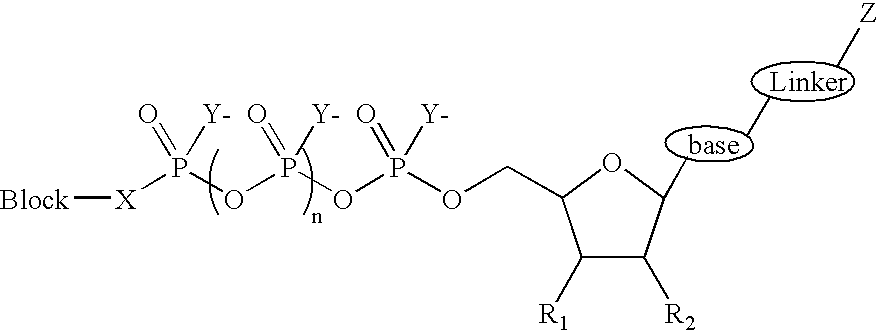Terminal phosphate blocked nucleoside polyphosphates
- Summary
- Abstract
- Description
- Claims
- Application Information
AI Technical Summary
Benefits of technology
Problems solved by technology
Method used
Image
Examples
example 1
[0047] Synthesis of Methyl-block Dye-labeled-2',3'-Dideoxynucleoside-5'-te-traphosphates: Synthesis of Fluorescein-18-ddA4P-Methyl 4
[0048] A. Preparation of FAM-18-ddATP 5
[0049] A solution of 18-ddATP (60 .mu.moles, in 5 ml 0.1M NaHCO3 / Na2CO3, pH 8.5) was cooled on an ice / water bath. To the solution was added 5-carboxy-fluorescein-NHS ester (35 mg, leq.) in DMF (5 ml). The reaction flask was removed from the cooling bath and the reaction mixture was stirred at room temperature for 16 hrs. The product purified by anion exchange chromatography and HPLC. The product containing fractions were concentrated then lyophilized to yield a yellow solid.
[0050] B. Preparation of Methyl-Phosphoimidazolidate
[0051] Methyl-monophosphate (50 .mu.mol) was coevaporated with anhydrous DMF (2.times.2ml) and tributylamine (50 .mu.mol). This was redissolved in anhy. DMF (0.5 ml) and treated with carbonyldiimidazole (200 .mu.mol, 5 eq.) for overnight. The reaction mixture was quenched by addition of methano...
example 2
Synthesis of Energy Transfer Dye Based Blocked Dideoxynucleoside-5'-tetrap-hosphate:FAM-TAMRA-ddA4P-Methyl
[0054] 6
[0055] FAM-TAMRA-18-ddATP was converted to the methyl tetraphosphate essentially the same way as reported above for the synthesis of FAM-18-ddA4P-Methyl. The yield from 10 .mu.mol of starting material was 8.5 .mu.mol. UV 495 and 556 nm. ESMS: 1644 (M-1).
example 3
Stability of Normal and Methyl Blocked Energy Transfer Terminator
[0056] A sequence reaction containing 25 mM HEPES 8.0, 3 mM MgCl2, 1 mM MnSO4, 200 micromolar dNTP, 0.01% tween-20, 20 units Thermo Sequenase I, 0.8 milliunits pyrophosphatase, 100 ng M13mp18, 5 .mu.moles universal -40 primer, and 3.5 micromolar FAM-TAM-18-ddATP was cycled 25 times from 95 degrees C, 15 seconds to 60 degrees C, 2 minutes. The reaction was then ethanol precipitated and electrophoresed on a MegaBACE 1000 sequencing machine (FIG. 2, Panel 1). If it was not ethanol precipitated, the breakdown products would appear as blobs on electropherogram and would interfere with fragments between 50-100 nucleotides long.
[0057] On the same MegaBACE run, 10 micromolar FAM-TAM-18-ddATP or 10 micromolar FAM-TAM-18-ddA4P-methyl in 25 mM HEPES 8.0, 3 mM MgCl2, 1 mM MnSO4, 0.01% tween-20 was electrophoresed directly (without precipitation) with or without heating at 95 degrees C for 20 minutes (Panel 2-5). It is clear from F...
PUM
| Property | Measurement | Unit |
|---|---|---|
| Electric charge | aaaaa | aaaaa |
| Thermal stability | aaaaa | aaaaa |
Abstract
Description
Claims
Application Information
 Login to View More
Login to View More - R&D
- Intellectual Property
- Life Sciences
- Materials
- Tech Scout
- Unparalleled Data Quality
- Higher Quality Content
- 60% Fewer Hallucinations
Browse by: Latest US Patents, China's latest patents, Technical Efficacy Thesaurus, Application Domain, Technology Topic, Popular Technical Reports.
© 2025 PatSnap. All rights reserved.Legal|Privacy policy|Modern Slavery Act Transparency Statement|Sitemap|About US| Contact US: help@patsnap.com



